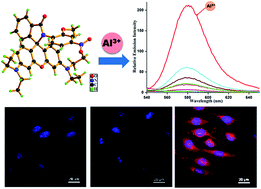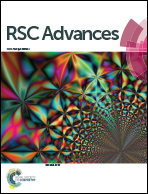A chemosensor for Al3+ ions in aqueous ethanol media: photophysical and live cell imaging studies†
Abstract
A novel fluorescent chemosensor L has been designed and synthesized based on the rhodamine-B moiety. The dye L exhibits selective fluorescence enhancement towards the Al3+ ion over other biologically relevant metal ions in aqueous ethanolic media (EtOH–H2O, 2 : 3, v/v). The structure of the probe L has been established by 1H and 13C-NMR spectroscopy, single crystal X-ray diffraction, ESI-mass spectrometry and elemental analysis. The cleavage of the spirolactam bond of the rhodamine moiety induced by the Al3+ ion generates the delocalized xanthene fluorophore that is responsible for the emission enhancement of the probe L. The recognition behavior of the receptor L has been investigated experimentally with supports from theoretical DFT studies. Furthermore, the efficacy of L in cell imaging studies is also probed by confocal microscopy.


 Please wait while we load your content...
Please wait while we load your content...